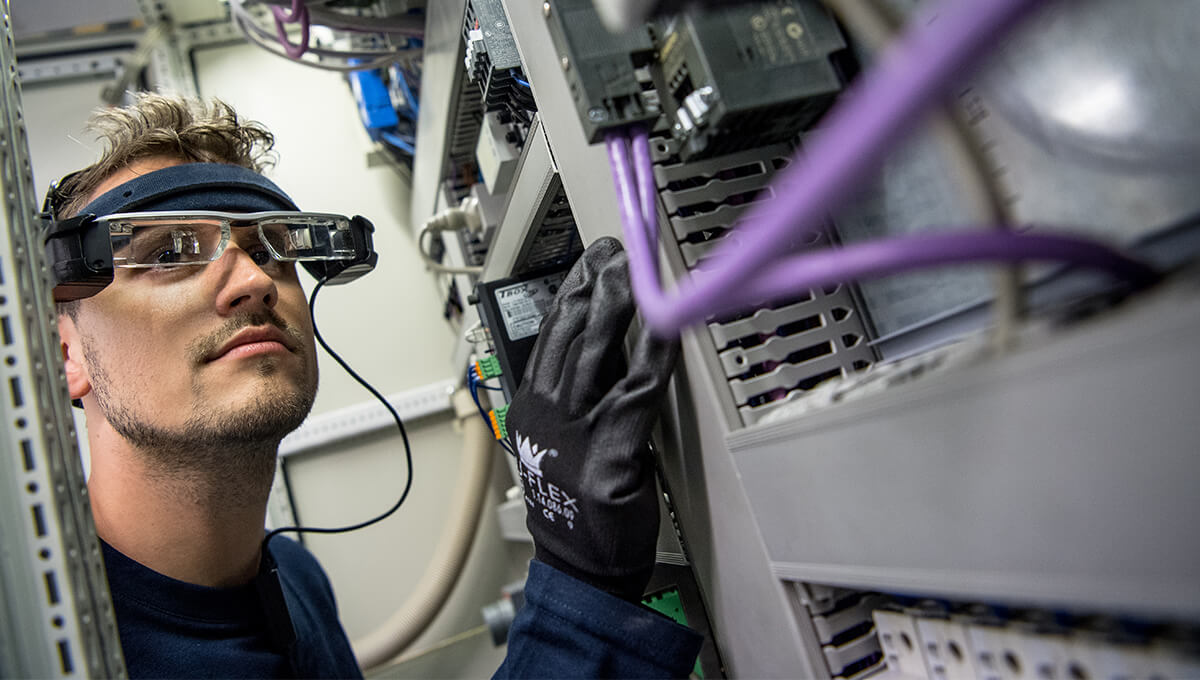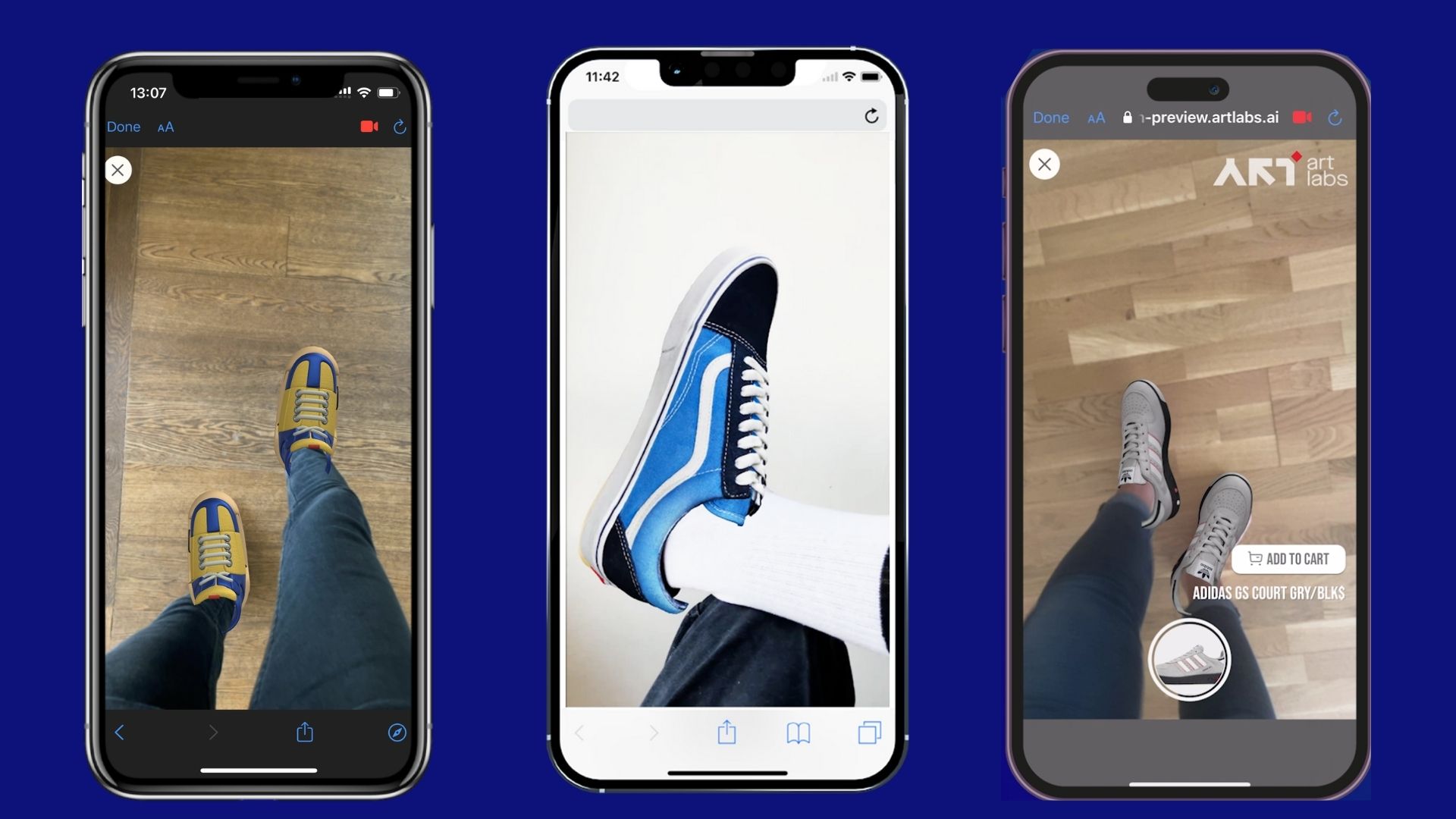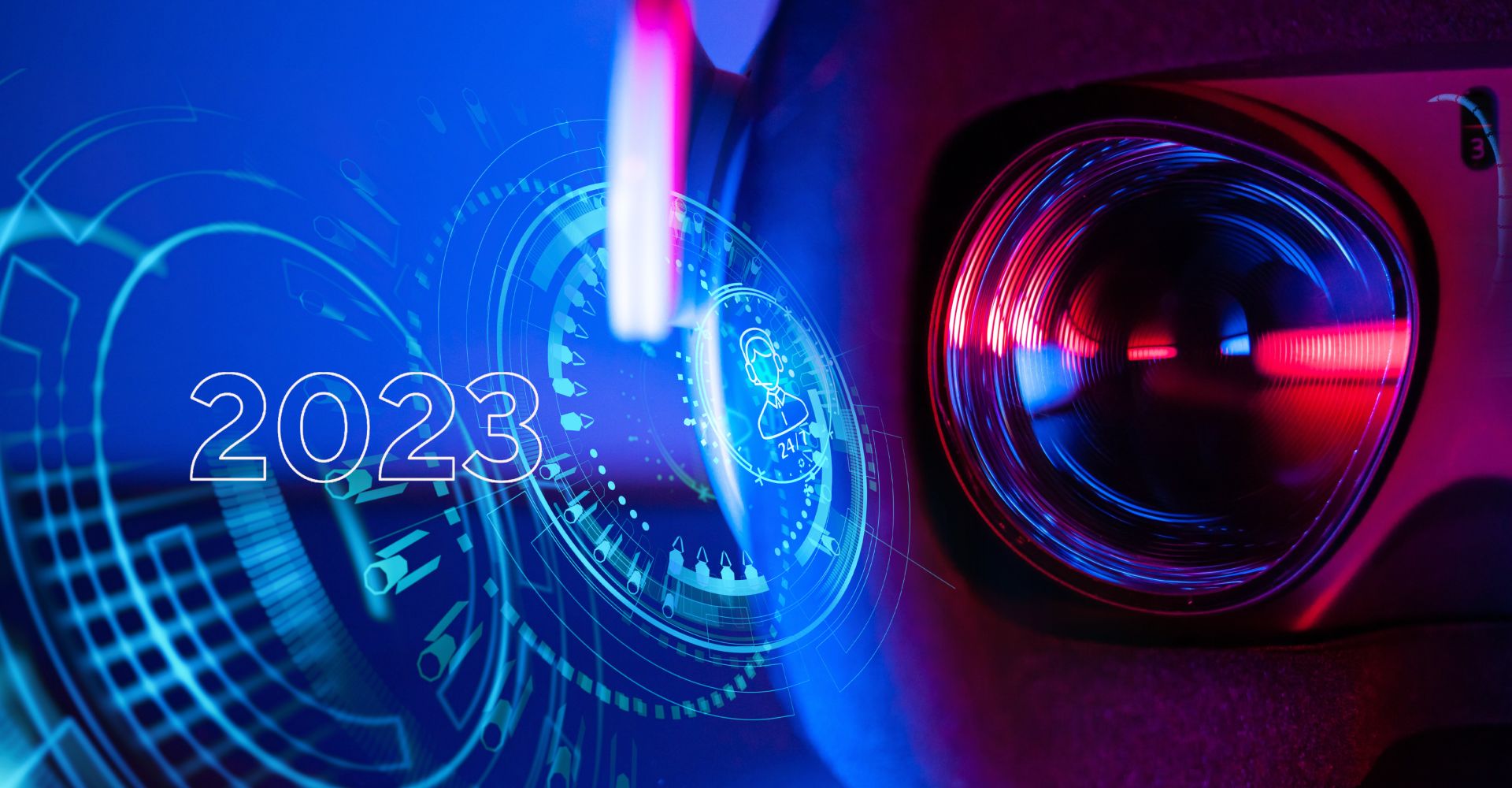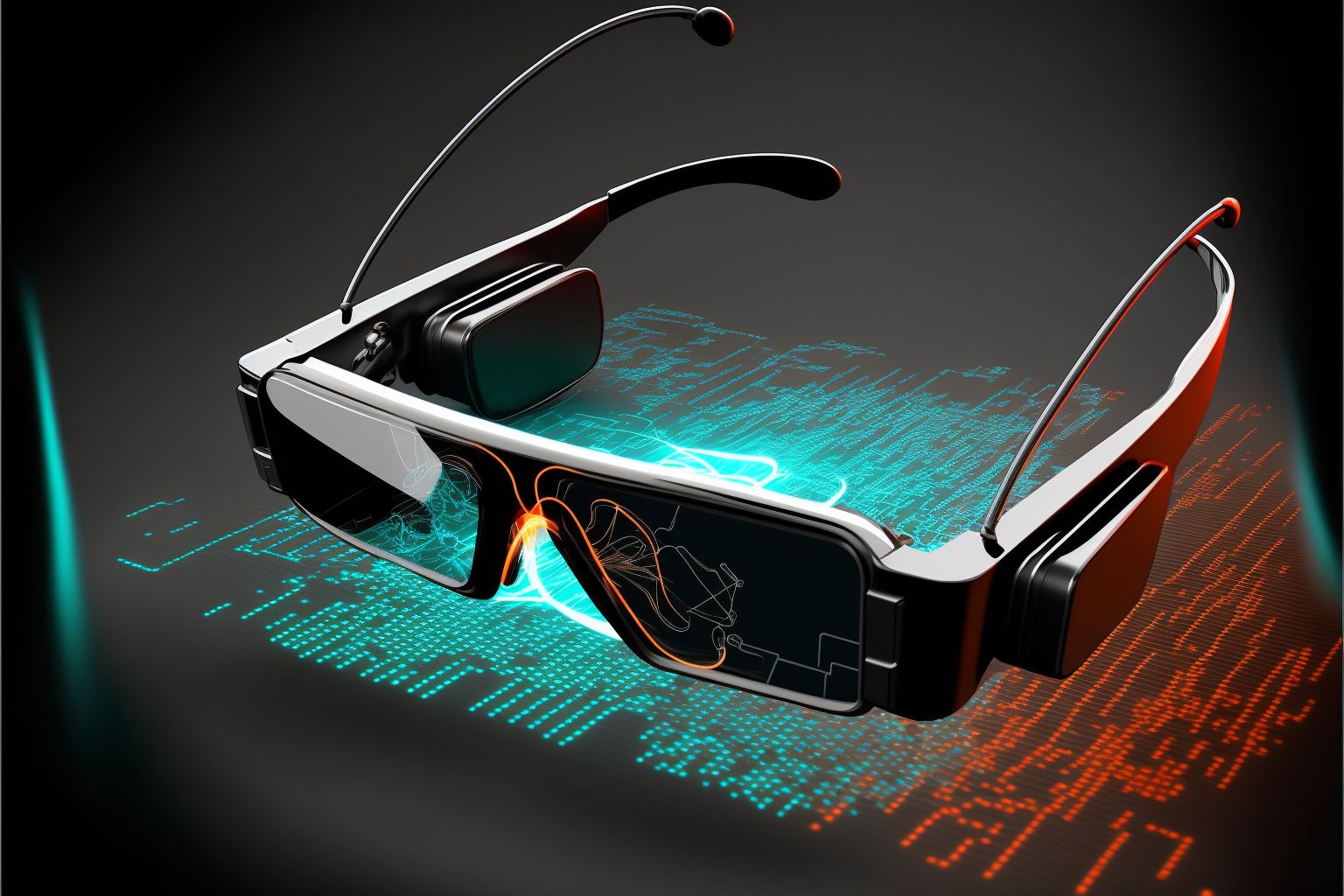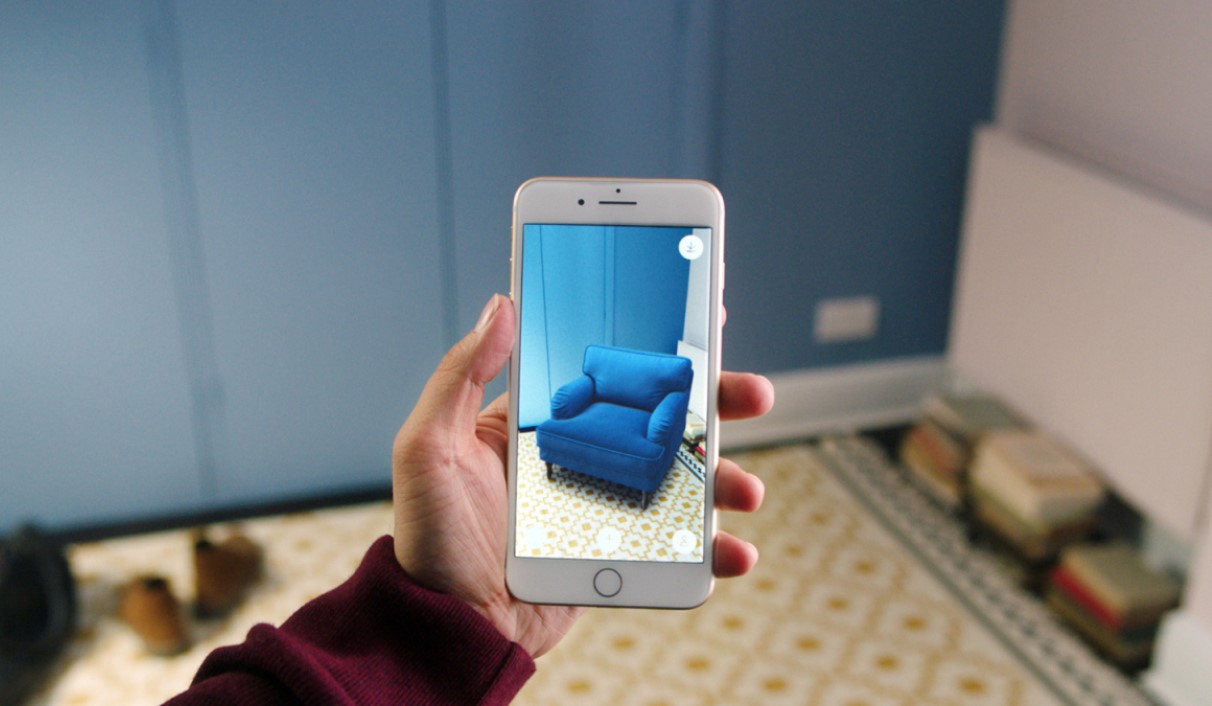Introduction
AR (Augmented Reality) smart glasses are a revolutionary technology that blends the real world with virtual elements, enhancing our perception and interaction with the environment. These cutting-edge glasses have gained significant attention in recent years and are captivating the imaginations of tech enthusiasts, designers, and everyday users alike.
AR smart glasses not only offer a glimpse into the future but also present a wealth of potential applications across various fields, including entertainment, gaming, healthcare, education, manufacturing, and more. From immersive gaming experiences to hands-free instructional guides in the workplace, the possibilities seem endless.
At their core, AR smart glasses utilize a combination of advanced technologies and sophisticated algorithms to bring the virtual world into our field of vision. The glasses are equipped with a range of components that work in harmony to create a seamless and immersive augmented reality experience.
In this article, we will delve into the workings of AR smart glasses, exploring the basic components, the underlying technology, and how they function to blend virtual content with the real world. We will also uncover the challenges and limitations these glasses face as they strive to become a mainstream technology in our everyday lives.
So, strap on your virtual seatbelt as we embark on a journey to understand the fascinating world of AR smart glasses and uncover how they are shaping the future of human-computer interaction.
What are AR Smart Glasses?
AR smart glasses, also known as augmented reality glasses, are wearable devices that overlay digital information, graphics, and virtual objects onto the real world. They are a form of head-mounted display (HMD) that allows users to experience and interact with virtual content without the need for a separate screen or device.
Unlike virtual reality (VR) headsets that completely immerse users in a virtual environment, AR smart glasses provide a blended experience, where virtual elements are seamlessly integrated into the user’s real-world view. This allows users to stay connected with their surroundings while enhancing their perception and interaction with digital content.
AR smart glasses come in various forms, ranging from sleek, lightweight frames to more robust designs. They are typically equipped with a display system, sensors, processing units, and an optical system to create the immersive augmented reality experience.
These glasses are designed to be portable and user-friendly, providing a hands-free experience. They often feature wireless connectivity, allowing users to access mobile applications, internet services, and other digital content directly through the glasses.
The applications of AR smart glasses are vast and diverse. In the entertainment industry, they can transform gaming experiences by overlaying virtual characters and objects onto the real environment, creating a truly immersive gameplay. In the healthcare sector, AR smart glasses can assist surgeons during complex procedures by providing real-time medical data and 3D visualizations.
In addition, AR smart glasses have the potential to revolutionize the way we learn and educate. They can offer interactive and engaging educational experiences, allowing students to visualize complex concepts and explore virtual environments.
Overall, AR smart glasses represent the convergence of digital and physical worlds, providing new avenues for communication, interaction, and information visualization. As the technology continues to evolve, we can expect to see more innovative applications and advancements in the field of augmented reality.
The Basic Components
AR smart glasses are made up of several key components that work together to deliver the augmented reality experience. Let’s take a closer look at these components:
- Display System: One of the most fundamental components of AR smart glasses is the display system. This system incorporates a small display or series of displays that project virtual content onto the user’s field of view. The display can be in the form of tiny screens, projectors, or even waveguide optics that utilize holographic elements to create the illusion of virtual objects blending seamlessly with the real world.
- Sensors and Trackers: AR smart glasses rely on various sensors and trackers to understand the user’s movements and the environment around them. These sensors, such as accelerometers, gyroscopes, and magnetometers, detect the motion and position of the user’s head, allowing the glasses to track their viewpoint accurately. Additionally, cameras and depth sensors enable the glasses to perceive the real-world objects and provide crucial data for the augmented reality experience.
- Processing Unit: The processing unit, often in the form of a powerful processor or a dedicated system-on-a-chip (SoC), is responsible for handling the complex computations involved in generating and rendering the augmented reality content. This unit processes the sensor data, performs real-time tracking, and executes the algorithms required to overlay virtual objects onto the real-world view.
- Optical System: The optical system of AR smart glasses is designed to ensure that the virtual content is presented in the most effective and immersive manner. It consists of lenses, waveguides, or mirrors that direct the light from the display system to the user’s eyes, creating the illusion of virtual objects appearing at a specific distance or location in the real world. The optical system plays a crucial role in achieving a clear and coherent augmented reality experience.
These basic components form the foundation of AR smart glasses, enabling them to blend virtual content with the real world seamlessly. The combination of display systems, sensors and trackers, processing units, and optical systems work in harmony to create an immersive augmented reality experience that captivates users and expands the possibilities of technology.
Display System
The display system is a crucial component of AR smart glasses that allows virtual content to be projected onto the user’s field of view. It plays a vital role in creating a seamless integration of the real world with virtual elements. There are several different types of display systems used in AR smart glasses, each with its own advantages and limitations.
One of the common display systems used in AR smart glasses is a small, built-in screen that sits in front of one or both eyes. These screens can be LCD (liquid crystal display) or OLED (organic light-emitting diode) panels, and they project the virtual content directly onto the user’s retina. By focusing the light onto the retina, the virtual content appears as if it is floating in front of the user, blending with the real-world view.
Another display system used in AR smart glasses is based on projectors. These glasses utilize miniature projectors to display the virtual images onto a semi-transparent or reflective surface, such as a lens or a beam splitter. The projected images are then reflected into the user’s eyes, creating the illusion of virtual objects within the real-world environment.
Waveguide optics are another type of display system commonly found in AR smart glasses. Waveguides are thin, transparent pieces of material that use total internal reflection to guide the light from a display source to the user’s eyes. Virtual content is projected onto the waveguide, and it travels along the waveguides until it reaches a specific point, where it is reflected into the user’s eyes, superimposing the virtual images onto the real-world scene.
Display systems in AR smart glasses have evolved significantly to provide a more immersive augmented reality experience. Advanced technologies, such as holographic displays, have emerged, offering the potential to create truly realistic and interactive virtual content. These displays use light diffraction and interference principles to create holograms, which can be viewed without the need for special glasses or optics.
As the field of AR smart glasses continues to advance, display systems will see further improvements in terms of resolution, brightness, and form factor. The goal is to achieve highly immersive and high-quality virtual content that seamlessly integrates with the user’s perception of the real world, creating rich and engaging augmented reality experiences.
Sensors and Trackers
Sensors and trackers are essential components of AR smart glasses that enable them to understand the user’s movements and the surrounding environment. These technologies play a crucial role in accurately tracking the user’s viewpoint and aligning virtual content with the real-world scene. Let’s explore the key sensors and trackers employed in AR smart glasses:
Accelerometers: Accelerometers detect changes in the speed and direction of the user’s head movements. By measuring acceleration forces, these sensors help determine the user’s orientation and movement in three-dimensional space. This information is crucial for tracking the user’s viewpoint and adjusting the virtual content accordingly.
Gyroscopes: Gyroscopes measure angular velocity and rotation, providing information about the orientation and rotational movements of the user’s head. By accurately tracking rotational changes, gyroscopes ensure that virtual objects are aligned with the user’s perspective, enhancing the realism and coherence of the augmented reality experience.
Magnetometers: Magnetometers measure the Earth’s magnetic field and provide a reference point for the user’s orientation. By incorporating magnetometers in AR smart glasses, the devices can determine the user’s heading and orientation relative to the Earth’s magnetic field. This helps maintain accurate alignment of virtual content with the real-world environment.
Cameras: Cameras are crucial sensors in AR smart glasses as they capture the real-world scene and provide visual data for tracking and mapping. These cameras can range from simple RGB cameras to depth cameras, which enable the glasses to perceive depth information and create a more realistic augmented reality experience. The captured visual data assists in recognizing objects, detecting surfaces, and accurately placing virtual content within the user’s environment.
Depth Sensors: Depth sensors, such as time-of-flight (ToF) cameras or structured light systems, measure the distance between the glasses and objects in the environment. By capturing depth information, these sensors help the glasses understand the physical structure of the surroundings, enabling accurate occlusion of virtual objects behind real-world objects and creating a more immersive augmented reality experience.
GPS and GNSS: Some AR smart glasses incorporate GPS (Global Positioning System) or GNSS (Global Navigation Satellite System) capabilities. These technologies provide precise location and positioning information, allowing the glasses to overlay location-based data onto the real-world view. This can be particularly useful in outdoor applications, such as navigation or tourism, where users can receive relevant information based on their current location.
By leveraging a combination of sensors and trackers, AR smart glasses can accurately track the user’s head movements, determine their position and orientation, and perceive the surrounding environment. This information is crucial for aligning virtual content with the real world, enabling realistic interaction, and providing an immersive augmented reality experience.
Processing Unit
The processing unit is a vital component of AR smart glasses that handles the complex computational tasks required to generate and render the augmented reality content. It plays a crucial role in ensuring seamless and real-time integration of virtual objects with the user’s real-world view. Let’s explore the key aspects of the processing unit in AR smart glasses:
AR smart glasses are equipped with powerful processors or dedicated system-on-a-chip (SoC) designs that are specifically optimized for augmented reality applications. These processors handle multiple tasks simultaneously, including sensor data processing, real-time tracking, image and video rendering, and running the algorithms necessary for the augmented reality experience.
The processing unit is responsible for fusing data from various sensors, such as accelerometers, gyroscopes, cameras, and depth sensors. By combining this data, the processing unit accurately determines the user’s position, orientation, and movements in real-time, ensuring that the virtual content aligns seamlessly with the user’s perspective.
This unit also performs real-time tracking, which is crucial for maintaining the stability and accuracy of the augmented reality experience. By continuously tracking the user’s head movements, the processing unit ensures that the virtual objects react in real-time to changes in the user’s viewpoint, providing a smooth and coherent augmented reality experience.
Moreover, the processing unit executes complex algorithms, such as simultaneous localization and mapping (SLAM), which enable the glasses to understand and map the surrounding environment. SLAM algorithms use sensor data to create a digital representation of the real-world environment, allowing the glasses to accurately place virtual objects on surfaces, recognize objects, and provide accurate occlusion of virtual content behind real-world objects.
In terms of rendering, the processing unit is responsible for generating and displaying the virtual content in real-time. It handles the rendering of 3D graphics, textures, animations, and other visual elements, ensuring that the augmented reality experience is visually appealing and realistic. Additionally, the processing unit optimizes the rendering process to maintain a smooth frame rate, minimizing any lag or latency between the user’s movements and the display of virtual content.
As AR smart glasses evolve, the processing units are becoming more powerful and energy-efficient, allowing for more sophisticated and immersive augmented reality experiences. Advancements in processing technology, such as AI (Artificial Intelligence) acceleration and machine learning, are also being integrated into AR smart glasses, enabling more intelligent and context-aware interactions with virtual content.
In summary, the processing unit in AR smart glasses acts as the brain, handling the complex computations, sensor data processing, real-time tracking, and rendering tasks necessary to create an immersive and seamless augmented reality experience.
Optical System
The optical system in AR smart glasses is a critical component that ensures the virtual content is presented effectively and realistically in the user’s field of view. This system is responsible for directing light from the display system to the user’s eyes, creating the illusion of virtual objects blending seamlessly with the real world. Let’s explore the key aspects of the optical system in AR smart glasses:
The optical system typically consists of lenses, waveguides, or mirrors that serve as conduits for directing light from the display system to the user’s eyes. These optical elements are designed to minimize aberrations, distortions, and reflections, ensuring a clear and immersive augmented reality experience.
In traditional AR smart glasses, lenses are used to focus the light from the display system onto the user’s retina. These lenses help create a clear virtual image that appears superimposed on the real-world scene. By carefully controlling the refraction and focal length of the lenses, the optical system ensures that the virtual objects are presented at the appropriate distance and size, maintaining visual coherence with the user’s surroundings.
Waveguide optics are another type of optical system commonly found in AR smart glasses. Waveguides are thin, transparent pieces of material that use total internal reflection to guide the light from the display system to the user’s eyes. Virtual content is projected onto the waveguide and travels along it until it reaches a specific point where it is reflected into the user’s eyes, creating the illusion of virtual objects in the user’s natural field of view.
Mirrors are also used in some AR smart glasses to redirect the light from the display system into the user’s eyes. These mirrors can be flat or curved, and they reflect the light at precise angles to ensure that the virtual content aligns accurately with the user’s perspective. Mirrors are particularly useful in compact and lightweight designs, allowing for a more comfortable and unobtrusive form factor.
The optical system is designed to minimize any visual artifacts, such as glare, ghosting, or distortion, which could negatively impact the augmented reality experience. It aims to provide a clear and crisp image with high contrast and resolution. Manufacturers employ anti-reflective coatings, light-blocking materials, and other optical techniques to optimize the performance of the system and enhance the visual quality of the virtual content.
As AR smart glasses advance, the optical systems are evolving to offer more advanced capabilities. For example, some glasses are incorporating eye-tracking technology into the optical system, allowing for dynamic adjustments of the virtual content based on the user’s gaze. This enables more precise interaction and intuitive control of virtual objects.
In summary, the optical system in AR smart glasses is responsible for creating an immersive and realistic augmented reality experience by directing light from the display system to the user’s eyes. It ensures visual coherence, clarity, and comfort, improving the overall quality of the augmented reality content and enhancing the user’s perception of virtual objects within the real world.
How do AR Smart Glasses Work?
AR (Augmented Reality) smart glasses work through a combination of advanced technologies and sophisticated algorithms to overlay virtual content onto the user’s real-world view. The process involves several key steps that enable the glasses to blend digital information seamlessly with the physical environment. Let’s explore how AR smart glasses work:
Tracking and Mapping the Environment: AR smart glasses use a variety of sensors, such as accelerometers, gyroscopes, cameras, and depth sensors, to track the user’s movements and understand the surrounding environment. These sensors continuously capture data on the user’s position, orientation, and the physical features of the environment. This information is fed into algorithms, such as simultaneous localization and mapping (SLAM), which create a digital representation of the real-world scene and track the user’s viewpoint in real-time.
Overlapping Virtual Content: Once the glasses have tracked the user’s position and orientation, they can overlay virtual content onto the real-world scene. This is achieved through the display system, which projects the virtual images or objects onto the user’s field of view. The optical system ensures that the virtual content aligns with the user’s perspective, creating the illusion that the virtual objects are occupying the same space as the physical objects in the environment. The virtual content is dynamically adjusted as the user moves, providing a seamless and immersive augmented reality experience.
Interaction Methods: AR smart glasses offer various interaction methods to engage with the virtual content. These can include gestures, voice commands, eye tracking, touch-sensitive frames, or even external input devices. By utilizing these interaction methods, users can manipulate and interact with virtual objects, access additional information, and perform actions within the augmented reality environment. These interactions are processed by the glasses’ software and algorithms, which interpret the user’s commands and trigger the appropriate responses.
Real-time Processing: AR smart glasses contain powerful processors or dedicated system-on-a-chip (SoC) designs that handle the processing and rendering tasks in real-time. These processors analyze the sensor data, perform complex calculations, and render the virtual content at a high frame rate, ensuring a smooth and responsive augmented reality experience. The processing units also execute algorithms to optimize the spatial mapping, occlusion, and tracking of virtual objects, enhancing the realism and fidelity of the augmented reality environment.
Connectivity and Integration: AR smart glasses often have wireless connectivity options, such as Bluetooth or Wi-Fi, which enable them to interact with other devices, applications, or online services. They can connect to smartphones, tablets, or computers, allowing users to access relevant data, apps, and internet services directly through the glasses. This integration expands the functionality and versatility of AR smart glasses, opening up a world of possibilities for entertainment, productivity, education, and more.
Through the combination of tracking and mapping the environment, overlapping virtual content, providing interaction methods, real-time processing, and integration with other devices, AR smart glasses create an immersive augmented reality experience that enhances the user’s perception and interaction with the surrounding world. As technology continues to advance, we can expect AR smart glasses to become even more powerful, versatile, and seamlessly integrated into our everyday lives.
Tracking and Mapping the Environment
Tracking and mapping the environment is a fundamental step in the operation of AR (Augmented Reality) smart glasses. By utilizing a variety of sensors and sophisticated algorithms, these glasses are able to understand the user’s movements and create a digital representation of the real-world scene. Let’s delve into the process of tracking and mapping the environment in AR smart glasses:
Sensors for Tracking: AR smart glasses incorporate a range of sensors, including accelerometers, gyroscopes, magnetometers, and cameras, to obtain a comprehensive understanding of the user’s movements and orientation. Accelerometers measure changes in acceleration, while gyroscopes detect rotational movements. Magnetometers provide information about the Earth’s magnetic field, enabling the glasses to determine the user’s heading. Cameras capture visual data of the surroundings, which is essential for mapping and interaction purposes.
Simultaneous Localization and Mapping (SLAM): One of the key algorithms used in AR smart glasses is Simultaneous Localization and Mapping (SLAM). SLAM combines the sensor data, such as the motion data from the accelerometers and gyroscopes, with visual data from the cameras, to simultaneously create a map of the environment and track the user’s position within that environment. This allows the glasses to accurately overlay virtual content onto the real-world scene.
Creating a Digital Representation: Through SLAM, AR smart glasses create a digital representation of the environment by continuously analyzing the sensor data. By identifying and tracking visual features, such as corners or edges, the glasses can construct a 3D map of the surroundings. This map is updated in real-time as the user moves, allowing the glasses to adapt and accurately align virtual content with the physical environment.
Real-Time Tracking: The tracking component of AR smart glasses is responsible for continuously updating the user’s position and orientation as they navigate through the environment. The glasses analyze the motion data from the sensors and use the map created through SLAM to calculate the user’s precise location. Real-time tracking ensures that the virtual content is accurately positioned and aligned with the user’s changing perspective, creating a seamless augmented reality experience.
Environmental Understanding: Through the combination of sensor data and the generated map, AR smart glasses gain an understanding of the real-world environment. They can recognize features, such as objects, surfaces, or obstacles, and use that information for various purposes. By understanding the environment, the glasses can provide accurate occlusion, where virtual objects appear to be positioned behind real-world objects, enhancing the realism of the augmented reality experience.
Tracking and mapping the environment are crucial steps in the functioning of AR smart glasses. By combining sensor data, sophisticated algorithms, and real-time processing, these glasses can create a digital representation of the real world and accurately overlay virtual content onto it. This tracking and mapping process enables a seamless blending of the physical and virtual worlds, opening up incredible possibilities for entertainment, education, collaboration, and many other fields.
Overlapping Virtual Content
One of the key features of AR (Augmented Reality) smart glasses is their ability to seamlessly overlay virtual content onto the user’s real-world view. This process of overlapping virtual content is essential for creating an immersive and interactive augmented reality experience. Let’s explore how AR smart glasses achieve this seamless integration:
Display System: AR smart glasses utilize a display system, such as built-in screens, projectors, or waveguide optics, to project the virtual content onto the user’s field of view. The display system ensures that the virtual images or objects appear as if they are blending with the real-world environment.
Optical System: The optical system of AR smart glasses plays a crucial role in aligning the virtual content correctly with the user’s perspective. By using lenses, waveguides, or mirrors, the optical system directs the light from the display system onto the user’s eyes, creating the illusion that the virtual objects are occupying the same space as the physical objects in the environment.
Real-Time Tracking: To achieve seamless overlap of virtual content, AR smart glasses continuously track the user’s movements and adjust the position and orientation of the virtual objects accordingly. The glasses use sensors, such as accelerometers, gyroscopes, and cameras, to track the user’s head movements and update the position and alignment of the virtual objects in real-time. This ensures that the virtual content appears integrated with and responsive to the user’s perspective.
Digital Representation: AR smart glasses create a digital representation of the user’s real-world environment through simultaneous localization and mapping (SLAM) algorithms. This digital representation, generated from sensor data and mapping techniques, helps the glasses understand the physical layout, surfaces, and objects in the environment. By accurately mapping the environment, the glasses can correctly position virtual content in relation to the real-world objects and surfaces.
Occlusion: One important aspect of overlapping virtual content is occlusion, where virtual objects are correctly displayed as being behind real-world objects. AR smart glasses achieve this by leveraging the digital representation of the environment. By recognizing the physical objects and surfaces captured by the sensors, the glasses can accurately render the virtual objects to appear as if they are positioned behind or interact with real-world objects, enhancing the realism of the augmented reality experience.
Dynamic Interaction: AR smart glasses enable dynamic interaction with the virtual content overlaid onto the real-world view. Users can manipulate, resize, or interact with the virtual objects using gestures, voice commands, or other input methods. The glasses detect the user’s interactions and adjust the virtual content accordingly, providing a responsive and interactive augmented reality experience.
Through the seamless overlap of virtual content, AR smart glasses create an immersive experience that blurs the boundaries between the physical and digital worlds. This technology has the potential to revolutionize various industries, including gaming, education, healthcare, and more, by providing users with a new level of interaction and engagement with their surroundings.
Interaction Methods
AR (Augmented Reality) smart glasses offer a variety of interaction methods that allow users to engage with the virtual content overlaid onto their real-world view. These interaction methods enable users to manipulate, control, and access information within the augmented reality environment. Let’s explore some of the common interaction methods used in AR smart glasses:
Gestures: Gestural interaction involves using hand or body movements to control and interact with the virtual content. AR smart glasses can recognize gestures such as swiping, pinching, pointing, or waving, allowing users to perform actions like resizing virtual objects, navigating menus, or initiating specific commands. Gestures provide an intuitive and natural way to interact with the augmented reality environment.
Voice Commands: Voice recognition technology allows users to control AR smart glasses through spoken commands. Users can issue voice commands to perform actions like launching applications, searching for information, or controlling virtual objects. Voice commands provide a hands-free and convenient interaction method, particularly in scenarios where manual input may be challenging or less practical.
Eye Tracking: Some AR smart glasses incorporate eye-tracking technology to detect the user’s gaze and movements of their eyes. Eye-tracking enables more precise and fine-grained interaction with the virtual content. For instance, users can select objects or initiate actions simply by looking at them or use eye movements to navigate menus or scroll through information. Eye tracking offers a natural and intuitive means of interaction, taking advantage of our natural visual focus and attention.
Touch-Sensitive Frames: AR smart glasses may feature touch-sensitive frames or surfaces that allow users to control the augmented reality experience through touch input. Users can tap, swipe, or perform multi-touch gestures directly on the glasses to interact with virtual objects, navigate menus, or access additional information. Touch-sensitive frames provide a familiar interaction method, similar to touchscreens on smartphones or tablets.
External Input Devices: Some AR smart glasses support external input devices, such as handheld controllers or motion trackers, for interaction. These devices can provide more precise and specialized input for gaming, design, or professional applications. Users can use controllers to manipulate virtual objects, navigate 3D spaces, or perform complex interactions that may require more dexterity and control.
Integration with Other Devices: AR smart glasses can also integrate with other devices, such as smartphones, tablets, or computers, to enhance interaction. Users can use their mobile devices as input devices or controllers, leveraging touchscreens, accelerometers, or gyroscopes for interaction with the augmented reality environment. This integration expands the possibilities for interaction and enhances the versatility of AR smart glasses.
These interaction methods offer users a range of options to engage with and control the virtual content in the augmented reality environment. The seamless integration of these methods into AR smart glasses provides an intuitive and immersive user experience, enabling users to interact with their surroundings in ways never before possible.
Challenges and Limitations
While AR (Augmented Reality) smart glasses hold immense potential, there are several challenges and limitations that need to be addressed for their widespread adoption and seamless functionality. Let’s explore some of the key challenges and limitations associated with AR smart glasses:
Form Factor and Comfort: AR smart glasses must strike a balance between being lightweight and comfortable to wear for extended periods. Achieving a sleek and ergonomic design that fits comfortably on different head sizes and shapes remains a challenge. Bulky or cumbersome designs may limit their adoption and hinder the overall user experience.
Display Quality: The quality of the display, including resolution, brightness, and clarity, is critical for an immersive augmented reality experience. AR glasses face the challenge of providing high-resolution, high-contrast, and vivid visuals while maintaining a compact and lightweight form factor. Advancements in display technology are necessary to enhance the visual quality and minimize any visual artifacts.
Battery Life: AR smart glasses are power-intensive devices that require sustained and efficient battery performance. The challenge lies in optimizing the power consumption of the processing units, display systems, and communication modules to ensure that the glasses can last for a reasonable amount of time without needing frequent recharging. Advances in battery technology and power management are crucial for improving the overall battery life of AR smart glasses.
Processing Power: AR smart glasses heavily rely on processing power for real-time tracking, mapping, rendering, and interaction. The challenge is to develop more powerful and energy-efficient processors or dedicated system-on-a-chip (SoC) designs that can handle complex computations while minimizing heat generation and power consumption. Advancements in semiconductor technology will be essential for improving the processing capabilities of AR smart glasses.
Environmental Factors: The performance of AR smart glasses can be affected by environmental factors such as lighting conditions, reflections, and occlusions. Bright or dim lighting conditions can impact the visibility of virtual content, while reflections on the glasses’ lenses can degrade the augmented reality experience. Additionally, occlusions caused by complex or dynamic real-world objects can challenge the accurate overlay of virtual content.
Content and Application Development: AR smart glasses require a rich ecosystem of content and applications to fulfill their potential. The challenge lies in developing compelling and diverse content that suits various industries and user needs. Additionally, creating intuitive and user-friendly AR applications that seamlessly integrate with the glasses’ features and interaction methods is crucial for a positive user experience.
Cost and Accessibility: The cost of AR smart glasses is another limitation that currently restricts their widespread adoption. High production costs and limited availability pose barriers to entry for many users. Advancements in manufacturing processes and economies of scale will help reduce costs and make AR smart glasses more accessible in the future.
Overcoming these challenges and limitations will require continued research, innovation, and collaboration across various disciplines. As technology advances, we can expect significant improvements in AR smart glasses, addressing these concerns and unlocking their full potential in transforming the way we interact with and perceive the world around us.
Conclusion
AR (Augmented Reality) smart glasses are transforming the way we perceive and interact with the world around us. These innovative devices blend virtual content with our real-world view, creating immersive and engaging augmented reality experiences. From gaming and entertainment to healthcare, education, and beyond, the applications of AR smart glasses are vast and promising.
AR smart glasses consist of several key components, including display systems, sensors and trackers, processing units, and optical systems. These components work together to track the user’s movements, overlay virtual content onto the real world, and provide intuitive interaction methods. The glasses leverage advanced technologies, such as simultaneous localization and mapping (SLAM), to understand and map the environment, ensuring accurate alignment of virtual objects with physical surfaces.
However, AR smart glasses still face challenges and limitations. The form factor and comfort of the glasses, display quality, battery life, processing power, environmental factors, content development, and cost are areas that require continuous improvements. Overcoming these challenges will be essential in realizing the full potential of AR smart glasses and making them accessible to a wider audience.
Despite these challenges, the future of AR smart glasses remains promising. With advancements in technology, we can expect sleeker designs, higher display resolution and clarity, longer battery life, faster and more efficient processors, and improved environmental tracking. These advancements will further enhance the immersive augmented reality experiences offered by smart glasses.
As AR smart glasses continue to evolve, they have the potential to revolutionize various industries, including gaming, education, healthcare, manufacturing, and more. They offer new ways to learn, work, communicate, and engage with digital content while staying connected to the real world.
In conclusion, AR smart glasses are paving the way for a future where the boundaries between the physical and digital worlds blur. As the technology advances, we can look forward to more seamless, immersive, and interactive augmented reality experiences that enhance our daily lives and unlock new possibilities for innovation and creativity.







